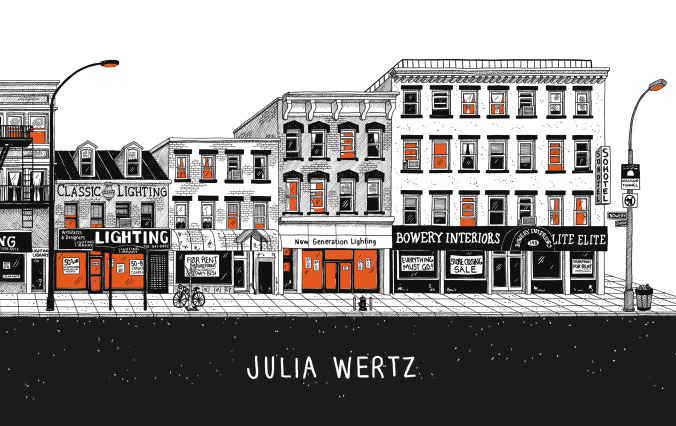More people would be willing to learn about local history if it was approached in a similar fashion as Julia Wertz’s Tenements, Towers & Trash (Black Dog & Leventhal) an “unconventional illustrated history of New York City” that eschews the typical tourist spots and prominent figures. Instead, Wertz focuses on lesser-known locations and people, recounting their stories with a mix of illustrated prose and short comics. Wertz lived in New York City for a decade before rising rents and an illegal eviction forced her out of the city, but there’s no bitterness in how she represents New York in this book. There are certainly some things about the city she dislikes, but in general this oversized hardcover is full of love and fascination for the myriad wonders of the five boroughs.
Tenements, Towers & Trash is a dense read, with over 250 pages packed with information about a wide array of subjects. There’s an astounding amount of detail in both the writing and artwork, indicating the huge scope of Wertz’s research and the intensity of her drive to depict building exteriors and interiors, floor plans, vehicles, and objects as accurately as possible. She breaks down the history of beloved New York City locales like C.O. Bigelow Apothecary, Kim’s Video, and Ray’s Pizza; offers guides to the city’s independent bookstores and hidden bars; and explores the evolution of street cleaning vehicles and snack carts over centuries. Her section on the egg cream is a great example of the thoroughness of her work, delving into the origins of the drink, popular recipe styles (original, economical, and artisanal), and where to find a good egg cream today. A page showing old-school hotel keys reveals how those tiny objects informed the building’s characters, offering a subtle message about how technology has removed the charms of the past.
Both Wertz’s graphic novel and Maggie Umber’s Sound Of Snow Falling showcase how comics can be used to preserve different environments on the page, and these two works highlight the versatility of the medium with their dramatically different approaches. Umber’s work is entirely driven by visuals with no text, whereas Wertz writes about different topics at length. That’s not always the case, though, and some of the most effective parts of Tenements, Towers & Trash are the illustrations that show how specific areas of the city have changed over time. While Umber keeps herself out of her chronicle of two owls surviving through the season, Wertz fully embraces her personal feelings about what she’s covering, adding extra emotion to the historical summaries.
Tenements, Towers & Trash ends on a poignant note, inspiring readers to look at their own surroundings in a different way and think about the history of what surrounds them as Wertz details a long walk she would take through multiple boroughs. She gives readers an impression of what it would be like to join her, and outlines her thought process as she takes in information around her, from ornate antique doorknobs to street corner fire alarms to remnants of cobblestone streets uncovered by potholes. After this comic, Wertz presents 11 two-page illustrations of locations she sees along this long walk, taking readers on one last, extended journey that represents what she loves so much about the city.


































![Rob Reiner's son booked for murder amid homicide investigation [Updated]](https://img.pastemagazine.com/wp-content/avuploads/2025/12/15131025/MixCollage-15-Dec-2025-01-10-PM-9121.jpg)





